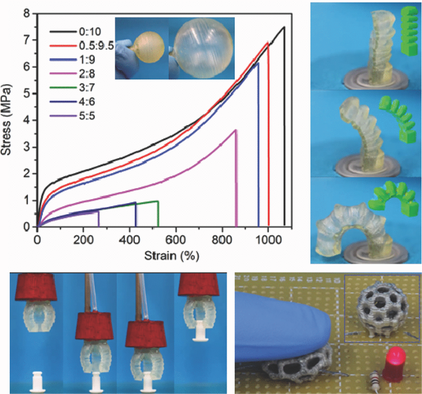Israel-Singapore Collaboration: Researchers Create Most Stretchable and UV Curable Elastomers Ever for 3D Printing
 As 3D printing has exploded into the mainstream, making an impact on nearly every industry worldwide, the technology has continued to evolve at an accelerated pace. Along with that, the study of materials and how they can improve 3D printing has been widely researched. Sometimes though, that works in the reverse, as 3D printing is used to improve the creation of the materials themselves—as in the case of elastomers.
As 3D printing has exploded into the mainstream, making an impact on nearly every industry worldwide, the technology has continued to evolve at an accelerated pace. Along with that, the study of materials and how they can improve 3D printing has been widely researched. Sometimes though, that works in the reverse, as 3D printing is used to improve the creation of the materials themselves—as in the case of elastomers.
Known as a versatile material that can be used in a wide range of applications, elastomers also offer both electrical and thermal insulation. Because of this they are currently popular for use in both electronics and smart biomedical devices, which require material that is flexible and adaptable. Manufacturing has been stumping modern researchers, however, due to the thermal curing process which requires those manufacturing it to cut, mold, and cast.
 Recent progress with elastomers is the result of research in a collaboration between the Singapore University of Technology and Design’s (SUTD) Digital Manufacturing and Design (DManD) Centre which is funded by the Singapore National Research Foundation (NRF), the Hebrew University of Jerusalem (HUJI), and the Campus for Research Excellence and Technological Enterprise (CREATE). Together, this team has created elastomers for creating more complex geometric shapes; in fact, their new elastomers are incredibly flexible and can also be manufactured via 3D printing with UV curing.
Recent progress with elastomers is the result of research in a collaboration between the Singapore University of Technology and Design’s (SUTD) Digital Manufacturing and Design (DManD) Centre which is funded by the Singapore National Research Foundation (NRF), the Hebrew University of Jerusalem (HUJI), and the Campus for Research Excellence and Technological Enterprise (CREATE). Together, this team has created elastomers for creating more complex geometric shapes; in fact, their new elastomers are incredibly flexible and can also be manufactured via 3D printing with UV curing.
“We have developed the most stretchable 3D printable elastomer in the world. Our new elastomers can be stretched by up to 1100% which is more than five times the elongation at break of any commercially available elastomer that is suitable for UV curing based 3D printing techniques,” said Assistant Professor Qi (Kevin) Ge from the SUTD’s DManD Centre, who is one of the co-leaders in developing the SUV elastomers.
“The new SUV elastomers enable us to directly print complicated geometric structures and devices such as a 3D soft robotic gripper within an hour. Compared to traditional molding and casting methods, using UV curing based 3D printing with the SUV elastomers significantly reduces the fabrication time from many hours, even days, to a few minutes or hours as the complicated and time-consuming fabrication steps such as mold-building, molding/demolding, and part assembly are replaced by a single 3D printing step.”
HUJI has provided us this video to show the stretch possible in this material:
These research findings were recently published in the Journal of Advanced Materials, in ‘Highly Stretchable and UV Curable Elastomers for Digital Light Processing Based 3D Printing,’ by Dinesh K. Patel, Amir Hosein Sakhaei, Michael Layani, Biao Zhang, Qi Ge, and Shlomo Magdassi. The researchers explain that in their work so far they have been able to create ‘highly deformable complex 3D hollow structures’ like:
- Balloons
- Soft actuators
- Grippers
- Bucky ball electronical switches
“Overall, we believe the SUV elastomers, together with the UV curing based 3D printing techniques, will significantly enhance the capability of fabricating soft and deformable 3D structures and devices including soft actuators and robots, flexible electronics, acoustic metamaterials, and many other applications,” said Professor Shlomo Magdassi, a co-leader of the project at HUJI and CREATE.
Discuss in the 3D Printed Elastomers forum at 3DPB.com.
Subscribe to Our Email Newsletter
Stay up-to-date on all the latest news from the 3D printing industry and receive information and offers from third party vendors.
You May Also Like
3D Printed Heat Spreader Could Improve Efficiency of Electronics
The low-hanging fruit for decarbonization has long been improving the efficiency of existing systems, hence the justification for LED lights and ENERGY STAR certified appliances. While such minor moves are...
3D Printing News Unpeeled: Marine Gearboxes, 3D Printed Motors and $1.7 Million in Seed Funding
UK based Equipmake just released their Ampere-220 e-axle system. The system, which is meant for high performance electric cars, was similar to one released on the Ariel HIPERCAR. It has...
CEAD Unveils 36-Meter-Long 3D Printer for Abu Dhabi’s Al Seer Marine
CEAD, a Dutch original equipment manufacturer dedicated to large-format 3D printers, has unveiled what it claims to be the world’s largest robotic arm-based 3D printer. At 36 meters long and...
3D Printed Biocomposites Could Help Reduce Marine Plastic Pollution
Concerns about the impact of plastic litter and microplastics in the oceans are at the forefront of environmental study. For decades, the marine environment has suffered from the degradation of...





































